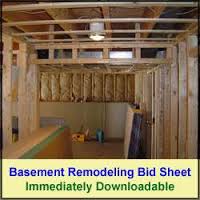Advantages and Disadvantages of Insulating Interior Basement Walls
By Mark J. Donovan
|
|
Insulating interior basement walls can save on home energy costs. If you have plans to finish your basement make sure your plans include insulating the interior basement walls. In addition, repair any foundation wall cracks, and consider applying a waterproof sealer to the interior foundations walls.
If you have major concerns about potential water problems in the basement you may want to talk with a foundation waterproofing company to see what other solutions may be right for you, e.g. installing gutters, a perimeter foundation drain, and/or water sealing the exterior basement walls. |
Advantages of Insulating Interior Basement Walls
There are a number of advantages to insulating interior basement walls. First, the cost of installing interior basement wall insulation is typically much less expensive than insulating exterior basement walls. Second, interior basement wall insulation is less prone to insect infestation and damage. Third, you can use a variety of insulation types, including rigid foam board insulation, and/or fiberglass batt insulation or rolled insulation. Finally, compared to insulating exterior basement walls, insulating interior basement walls provides better isolation from the cold soil surrounding the basement foundation.
| Disadvantages of Insulating Interior Basement Walls
Insulating interior basement walls does have a few disadvantages compared to insulating exterior foundation walls. First, using 3.5 inch (R11) or 6 inch (R-19) thick fiberglass batt or rolled insulation reduces the living space within the basement. This is a particular concern if the basement is relatively small. Second, when insulating interior basement walls it is critical to use an insulation solution that has a fire retard covering. Insulation can release toxic gases if burned, so the fire retard helps to mitigate the exposure to toxic gasses when ignited. |

Use this basement remodeling checklist and save time and money. |
Third, if there are exterior cracks in the foundation or there is a poor drain system around the foundation, ground water can wick through the foundation walls and damage the insulation, and cause mold and mildew to form on the insulation.
Insulating the exterior foundation walls, on the other hand, can help to mitigate water penetration into the basement walls. Fourth, insulating basement interior walls is typically more expensive than insulating a basement ceiling, though insulating basement walls yields better energy cost savings compared to insulating a basement ceiling.
Finally, the proper installation of a vapor diffusion retarder (vapor barrier) is critical when insulating interior basement walls. A vapor barrier helps to prevent condensation moisture from damaging the insulation. If the insulation becomes moisture laden, mold and mildew growth is inevitable.
For help on building a home addition, see HomeAdditionPlus.com’s Home Addition Bid Sheets. Our Home Addition Bid Sheets provide you with the knowledge and information on how to plan a home addition project, and what to look for when hiring contractors. They also include detailed cost breakdown tables and spreadsheets for estimating your own new home addition building costs.
Related Information
- Insulating R-Value Types for Different Areas of the Home
- Closed Cell Spray Foam Insulation
- Insulating a Crawl Space
Free Home Addition Price Quotes with No Obligation!
Fill out our 3-5 minute quick and easy form, and receive a free price quote on a house addition from one of our prescreened and licensed home addition contractors. This process is free and there is no obligation to continue once you receive your house addition price estimate.
